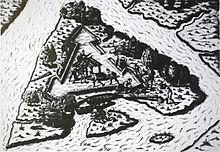Fort Caroline
| Fort Caroline National Memorial | |
|---|---|
IUCN category V (protected landscape/seascape) | |
| Location | Jacksonville, Florida, USA |
| Area | 138.39 acres (0.56 km²) |
| Established | January 16, 1953 |
| Visitors | 145,736 (in 2005) |
| Governing body | National Park Service |


Fort Caroline was the first French colony in the present-day United States. Established in what is now Jacksonville, Florida in 1564, it lasted only a year before being obliterated by the Spanish.
History
A French expedition, organized by Protestant leader Admiral Gaspard de Coligny and led by the Norman navigator Jean Ribault had landed at the site on the River of May (now the St. Johns River) in February 1562, before moving north to Port Royal Sound. There, on present-day Parris Island, South Carolina, Ribault left twenty eight men to build a settlement known as Charlesfort. Ribault then returned to Europe to arrange supplies for the new colony, but was arrested in England due to complications arising from the French Wars of Religion, which prevented his return.
Without supplies or leadership, and beset by hostility from the native populations, all but one of the colonists sailed back to Europe after only a year. During their voyage in an open boat, they were reduced to cannibalism before the survivors were rescued in English waters. Meanwhile, René Goulaine de Laudonnière, who had been Ribault's second-in-command on the 1562 expedition, led a contingent of around 200 new settlers back to Florida, where they founded Fort Caroline (or Fort de la Caroline) atop St. Johns Bluff on June 22, 1564. The fort was named for the reigning French king, Charles IX. For just over a year, this colony was beset by hunger, Indian attacks, and mutiny, and attracted the attention of Spanish authorities who considered it a challenge to their control over the area.
In June of 1565, Ribault had been released from English custody, and Coligny sent him back to Florida. In late August, Ribault arrived at Fort Caroline with a large fleet and hundreds of soldiers and settlers and took command of the settlement. However, the recently appointed Spanish Governor of Florida, Don Pedro Menéndez de Avilés, had simultaneously been dispatched from Spain with orders to remove the French outpost, and arrived within days of Ribault’s landing. After a brief skirmish between Ribault's ships and Menéndez's ships, the latter retreated 35 miles south, where they established the settlement of St. Augustine. Ribault pursued the Spanish with several of his ships and most of his troops, but he was surprised at sea by a violent storm lasting several days. In a bold stroke, Menéndez marched his forces overland, launching a surprise dawn attack on the Fort Caroline garrison which then numbered about 200 to 250 people. The only survivors were about 50 women and children who were taken prisoner and a few defenders, including Laudonnière, who managed to escape; the rest were executed.
As for Ribault's fleet, all of the ships either sank or ran aground south of St. Augustine during the storm, and many of the Frenchmen onboard were lost at sea. Ribault and his marooned sailors were located by Menéndez and his troops and summoned to surrender. Apparently believing that his men would be well treated, Ribault capitulated. Menéndez then executed Ribault and several hundred Frenchmen as Lutheran heretics at a place now known as Matanzas ("massacres") Inlet. This atrocity shocked Europeans even in that bloody era of religious strife.[1] This place is known today by a fort built much later, Fort Matanzas. This massacre put an end to France's attempts at colonization of the southeast coast of North America.
The Spanish destroyed Fort Caroline, but built their own fort on the same site. In April 1568, Dominique de Gourgues led a French force which attacked, captured and burned the fort. He then slaughtered all his Spanish prisoners in horrible revenge for the 1565 massacre.[2] The Spanish rebuilt, but permanently abandoned the fort the following year. The exact location of the settlement is not known.
Reconstruction
Fort Caroline was authorized as a National Memorial on September 21, 1950, and established on January 16, 1953. The memorial features a scaled-down reconstruction of the fort, based on historic renderings, and a visitor center. The memorial is administered in conjunction with Timucuan Ecological and Historic Preserve. As with all historic areas administered by the National Park Service, the memorial was listed on the National Register of Historic Places on October 15, 1966.


References
- The National Parks: Index 2001–2003. Washington: U.S. Department of the Interior.
- Morison, S. E. The European Discovery of America: The Northern Voyages AD 500-1600. New York: Oxford Press, 1971.
Footnotes
External links
- Fort Caroline National Memorial - official National Park Service website
- Fort Caroline shown on an engraving by Jacques Le Moyne
- Les expéditions françaises en Floride (1562-1568) - In French by Hélène LHOUMEAU
- Robert Viking O'Brien's article on the French Florida colony from The Marjorie Kinnan Rawlings Journal of Florida Literature
- Fort Matanzas National Monument
- IUCN Category V
- 1562 establishments
- 1953 establishments
- Buildings and structures in Jacksonville, Florida
- Forts in Florida
- French North America
- History of Jacksonville, Florida
- Huguenot history
- Lost cities and towns
- National Memorials of the United States
- Registered Historic Places in Duval County, Florida
- National parks in Florida
